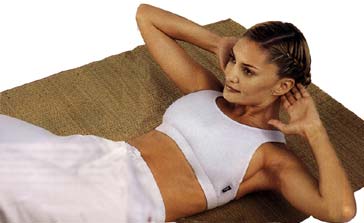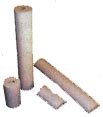Australia Sunday Life Magazine, March 23, 2003, page 34CORE CONTROL
A rippling sixpack might be eye-catching, but real strength - and wellbeing - dwells in your body's core.by ELIZA COMPTONFOR AMANDA FENTON, IT'S THE difference between saving a goal and crashing to the ice. "At our last away tournament, we got hit and fell over because we weren't as strong," says the 2S-year-old defence for the Australian women's ice hockey team. "But we played New Zealand in July and there was a lot of body contact and, because we were physically stronger, it helped us stand up to that. We won the series three to nil."
"It" is core strength and it's the new buzz on the gym floor. Elite athletes, dancers, and yoga and Pilates devotees have long known that the trunk is key to strength, injury prevention and performance. Now the rest of us are catching on, and paying attention to the power pack that holds us upright, supports the spine and transfers energy from the body's centre to the limbs. And more people are finding that traditional gym workouts, which use just one plane of motion, can't train the balance, coordination and stability required for real life. What good is a rippling sixpack or bulging biceps if you strain your back twisting to place the shopping in the car?
Fenton, an officebound project analyst when not on skates, says 18 months of core training has given her body a powerful foundation. "It makes you stand up straighter. And from a body-shaping perspective, you notice the difference." The ice hockey team's strength and conditioning coach, and personal trainer, Scott Wilson says the squad has increased its bench press weights by 15-20 kilograms.
CORE FITNESS KIT
Any of these items will help you build a more balanced home workoutSwiss ball. Use to increase core strength and stability, balanc flexibility. Expect to pay about $70 for a 65cm model. To fit, hips should be level with or slightly higher than the knees when sitting. Exercises include crunches, free-weight routines and stretches.
........................Wobble board. These are great to train balance, proprioception (your awareness of your body in space), core strength and reaction time. Exercises start from simply standing on the disc to advanced ball drills while standing on one leg. Order through physios or the internet. About $50.
........................Foam rollers. Place this metre-long polystyrene cylinder under your spine - head supported, feet flat and knees at 90 degrees - and work the arms with free weights. Or place hands on the ground to do leg exercises. The Pilates Institute of Australasia has large, $60.50, and small, $27.50, (02) 8920 2622; www.pilates.net
........................Duradisc. It's the size of a vinyl record and filled with air. Try standing on it on one leg to improve balance, ankle strength and proprioception. Sit on it and give your abs a workout on an unstable base; $85 from AOK Health, 1300 790 900.
........................Medicine ball. This old torture device bears another look for its versatility: to increase the intensity of situps or to train in pairs. Try standing back to back and passing it to each other in a circle. Available in weights from 1 kg, $40, from Rebel, (02) 9795 6500.
By contrast, "a weak core can result in overuse injuries and a body that is more subject to wear and tear," says US fitness expert Paul Frediani, author of Power Sculpt: The Core Strengtb, Flexibility, and Body Sculpting Program (Hatherleigh Press, $US16.95). "It will also decrease the ability to quickly stabilise and react."
So what is the core exactly? Think of the body as a cylinder bounded by the diaphragm, pelvic floor, tranversus abdominus (deepest abdominal muscle, which wraps around the body like a girdle and attaches to the lumbar vertebrae), multifidus (deepest back muscles, which act like support ropes from the vertebrae) and the internal and external obliques. You can't see these muscles, so they are often neglected.
"In the 70s and 80s, the emphasis was on cardiovascular fitness and muscle strength," says Lisa Westlake, physiotherapist and author of Strong To The Core (ABC Books, $25.95). "In the 90s, balance, co-ordination and core strength came into play." The result is the rising popularity of aids such as Swiss balls and Pilates classes. Reebok has introduced the Core Board (like a skateboard on a central pivot) and, in the US, core-training classes, which launch in Australia later this year.
These, plus other equipment (see box), create an unstable platform for exercise. You have to balance the body or twist as well as lift the weight, and that's where the benefit is. But you can start with a four-exercise routine (see box) on the floor, three times a week.
To begin core training, you must turn on those deep muscles. Gently draw the abdominals towards the spine as though tightening a low belt. Keep breathing normally. It can take a while for beginners to get the right feeling. If you feel your pelvic floor rise, you're on the right track.
"We should be encouraging people to be doing abdominal setting [activating the stabilising muscles] during all exercises running, bike riding, aerobics - and their form will improve," says Westlake. "Core stability makes rapid movement safer. A mother has to turn, run and catch successfully, just like a footballer."
Philippa Maughan, 33, needed abdominal strength while rehabilitating from a chronically inflamed knee. "I have to isolate the [quadricep and gluteall muscles in order to exercise them. It's a lot easier with strong abs, and it has made for better awareness of posture. And lifting and carrying is easier."
Four main trunk movements are involved in building core stability: flexion (for example, sit-ups), rotation (oblique crunches), extension (back extension), and stabilisation (prone holds - balancing on elbows and toes with a straight spine). A good program should include all of these, with the aim of training the body as a functional unit. Champion golfer Nick Faldo uses a core program that includes abdominal curls, oblique curls, side leg lifts (both legs together, head down) and prone holds to build a stroke that can whack a ball 250 metres.
But training a strong core doesn't mean neglecting other aspects - such as cardio and stretching. Fenton's hockey routine also includes swimming, agility and skills sessions. "Core stability is or everything," says Westlake. "It's part of a system of fitness, but it has been a missing piece."
TRY THESE AT HOME
This quick floor routine will work your core abdominals and back muscles. 1. Back extension. Lie face down. Draw in your lower stomach towards your spine to activate the transverse abdominus. Lift an arm and opposite leg. Do three sets of 10 each side. 2. Sit-up. Lie on your back, knees bent at 90 degrees with feet flat on the floor. Place your tongue between your teeth to relax your jaw and neck. Don't hold your breath! Place hands on thighs and push hands to knees, bringing your chin to your chest. Do three sets of 10. 3. Oblique crunch. Lie on your back (or sit on a swiss ball, rolling forward so the lower back is supported), with knees at 90 degrees and feet flat on the floor. Place your hands on either side of your head, elbows back. Put your tongue between your teeth. Bring opposite elbow towards your knee, contracting oblique muscles. Do two sets of 10 each side. 4. Prone hold. Start face down, resting on forearms. Draw in lower stomach. Raise body and support it on elbows and knees, keeping spine straight. Hold for 10 seconds. Repeat three times. Increase challenge by using elbows and toes. |
Photography: Steve Baccon. Styling: Fabienne Apert. Hair and Make-up: Sharon Leigh. Model: Natalie@ACM.
Equipment photos courtesy of AOK Health and the Pilates Institute of Australasia.
Equipment photos courtesy of AOK Health and the Pilates Institute of Australasia.






